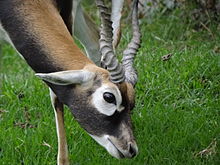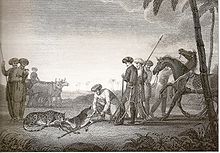The blackbuck is a diurnal antelope (active mainly during the day). Three kinds of groups, typically small, are the female, male and bachelor herds. Males often adopt lekking as a strategy to garner females for mating. While other males are not allowed into these territories, females often visit these places to forage. The male can thus attempt mating with her. Herbivores, blackbuck graze on low grasses, occasionally browsing as well. Females become sexually mature at eight months, but mate no earlier than two years. Males mature later, at one-and-a-half years. Mating takes place throughout the year. Gestation is typically six months long, after which a single calf is born. The lifespan is typically 10 to 15 years.
The blackbuck inhabits grassy plains and slightly forested areas. Due to their regular need of water, they prefer areas where water is perennially available.
The antelope is native to and found mainly in India, while it is extinct in Bangladesh. Formerly widespread, only small, scattered herds are seen today, largely confined to protected areas. During the 20th century, blackbuck numbers declined sharply due to excessive hunting, deforestation and habitat degradation. The blackbuck has been introduced in Argentina and the United States. The International Union for the Conservation of Nature and Natural Resources (IUCN) lists the blackbuck as Near Threatened. In India, hunting of blackbuck is prohibited under Schedule I of the Wildlife Protection Act of 1972. The blackbuck has significance in Hinduism; Indian and Nepali villagers do not harm the antelope.

Etymology
The scientific name of the blackbuck is Antilope cervicapra. Its generic name stems from the Latin word antalopus ("horned animal").[2][3] The specific name cervicapra is composed of the Latin words cervus ("deer") and capra ("she-goat").[2][4] The vernacular name "blackbuck" (pronounced /ˈblak-ˌbək/) is a reference to the dark brown to black colour of the dorsal (upper) part of the coat of the male.[5] The earliest recorded use of this name dates back to 1850.[6] Alternative names for the blackbuck are "Indian antelope",[7] kadiyal, kala hiran, krishna mrig and krishnasaar (in Hindi); krishna jinka (in Telugu); and iralai maan (in Tamil).[8][9][10]
Taxonomy and evolution
The blackbuck is the sole member of the genus Antilope and is classified under the family Bovidae. The species was described and given its binomial name by Swedish zoologist Carl Linnaeus in the 10th edition of Systema Naturae in 1758.[11][12] Antilope also includes fossil species, such as A. subtorta, A. planicornis, and A. intermedius.[13]
Antilope, Eudorcas, Gazella and Nanger form a clade within their tribe Antilopini. A 1995 study of the detailed karyotype of Antilope suggested that within this clade, Antilope is closest to the Gazella group.[14] A 1999 phylogenetic analysis confirmed that Antilope is the closest sister taxon to Gazella,[15] although an earlier phylogeny, proposed in 1976, placed Antilope as sister to Nanger.[16] In a more recent revision of the phylogeny of Antilopini on the basis of sequences from multiple nuclear and mitochondrial loci in 2013, Eva Verena Bärmann (of the University of Cambridge) and colleagues reexamined the phylogenetic relationships and found Antilope and Gazella to be sister genera distinct from the sister genera Nanger and Eudorcas.[17][18]
|
|||||||||||||||||||||||||||||||||||||||||||||||||
- A. c. cervicapra (Linnaeus, 1758) : Known as the southeastern blackbuck. Occurs in southern, eastern and central India. The white eye ring of the male is narrow above the eye and the leg stripe is well defined and reaches all along the leg.
- A. c. rajputanae Zukowsky, 1927 : Known as the northwestern blackbuck. Occurs in northwestern India. Males have a grey sheen to the dark parts during the breeding season. The white eye ring is broad all around the eye with the leg-stripe going only down to the shanks.
Genetics
The blackbuck shows variation in its diploid chromosome number. Males have 31-33 while females have 30-32. Males have a XY1Y2 sex chromosome.[21][22] Unusually large sex chromosomes had earlier been described only in a few species, all of which belonged to Rodentia. However, in 1968, a study found that two artiodactyls, the blackbuck and the sitatunga, too showed this abnormality. Generally the X chromosome constitutes 5 percent of the haploid chromosomal complement; but the X chromosome of the blackbuck this percentage is 14.96. Portions of both peculiarly large chromosomes show delayed replication.[23]
A 1997 study found lower protein polymorphism in Antilope in comparison with Antidorcas, Eudorcas and Gazella. This was attributed to a history of rapid evolution of an autapomorphic phenotype of Antilope. This might have been aided by a particularly strong selection of a few dominant males due to its lekking behaviour.[24]
Description
| Blackbuck – male and female | ||||
|---|---|---|---|---|
|
The white fur on the chin and around the eyes is in sharp contrast with the black stripes on the face. The coat of males shows two-tone colouration: while the upper parts and outsides of the legs are dark brown to black, the underparts and the insides of the legs are all white. Darkness typically increases as the male ages.[26] On the other hand, females and juveniles are yellowish fawn to tan.[26] In Texas, blackbuck moult in spring, following which the males look notably lighter, though darkness persists on the face and the legs.[25] On the contrary, males will grow darker as the breeding season approaches.[26] Both melanism[27] and albinism have been observed in wild blackbuck. Albino blackbuck are often zoo attractions as in the Indira Gandhi Zoological Park (Andhra Pradesh, India).[28]
Blackbuck bear a close resemblance to gazelles, and are distinguished mainly by the fact that while gazelles are brown in the dorsal parts, blackbuck develop a dark brown or black colour in these parts.[5]
Ecology and behaviour
A herd of blackbuck
Males often adopt lekking as a strategy on the part of males to garner females for mating. Territories are established by males on the basis of the local distribution of female groups, which in turn is determined by the habitat, so as to ensure greater access to females.[30] The males actively defend resources in their territories, nearly 1.2 to 12 hectares (3.0 to 29.7 acres) in size;[25] territories are marked with scent (using preorbital gland and interdigital gland secretions, faeces and urine)[31][32] While other males are not allowed into these territories, females are allowed to visit these places to forage. The male can attempt mating with visiting females. Lekking is a demanding strategy, as the males often have to bear injuries – thus it is a tactic typically adopted by strong, dominant males. Males may either defend their mates or try to forcibly copulate with them. Weaker males, who may not be dominant, might choose the second method.[33]
Blackbuck are severely affected by natural calamities such as floods and droughts, from which they can take as long as five years to recover.[34] Wolves are major predators;[35] a study found that old rutting bulls might be vulnerable to wolves.[34] Cheetahs and pariah dogs are the other predators.[5] Juveniles are also hunted by jackals. Village dogs are reported to kill fawns, but are unlikely to successfully hunt and kill adults.[36]
Diet
Blackbuck prefer grasses.
Reproduction
Courtship display in blackbuck
Gestation is typically six months long,[42] after which a single calf is born.[25] Newborn are a light yellow; infant males may have a black patch on the head and the neck.[9] Young are precocial - they can stand on their own soon after birth.[12] Females can mate again after a month of parturition.[25] Juveniles remain active and playful throughout the day. Juvenile males turn black gradually, darkening notably after the third year.[9] The lifespan is typically 10 to 15 years.[5][25]
Habitat and distribution
Blackbuck prefer grassy plains.
The antelope is native to and found mainly in India, while it is extinct in Bangladesh.[1] Today, only small, scattered herds are seen, largely confined to protected areas.[43] English naturalist William Thomas Blanford, in his 1891 The Fauna of British India, including Ceylon and Burma, described the range of the blackbuck in those times as:[11]
Blackbuck in the Ranibennur Blackbuck Sanctuary (Karnataka, India)
Along the base of the Himalayas from the Punjab to Nepal, and probably in most parts of the Peninsula where the country is wooded and hilly, but not in dense jungle ... it is common in the wooded parts of Rajputana, throughout the Bombay Presidency, the Central Provinces, and the northern parts of Madras, less abundant to the eastward in Chhattisgarh, Chutia Nagpur [sic], Bengal and Orissa, and to the southward in Mysore, but it occurs in the latter state occasionally, and has been observed on the Nilgiri and Palni hills. It is unknown in Ceylon and east of the Bay of Bengal.
Pair of blackbucks in Rehekuri Blackbuck Sanctuary (Maharashtra, India)
Royalty hunting blackbuck with Asiatic cheetah in South Gujarat, 1812
Threats and conservation
During the 20th century, blackbuck numbers declined sharply due to excessive hunting, deforestation and habitat degradation. Some blackbucks are killed illegally especially where they are sympatric with nilgai.[1] Until India's independence in 1947, blackbuck and chinkara were hunted in many princely states with specially trained captive Asiatic cheetahs.[43] By the 1970s, blackbuck were extinct in several areas.[46] Nevertheless, populations in India have increased from 24,000 in the late 1970s to 50,000 in 2001[citation needed]. The International Union for the Conservation of Nature and Natural Resources (IUCN) lists the blackbuck as Near Threatened.[1] CITES (Washington Convention) lists the blackbuck under Appendix III (Nepal).[19]In India, hunting of blackbuck is prohibited under Schedule I of the Wildlife Protection Act of 1972.[10][47] They occur in several protected areas of India, including: Kaimur Wildlife Sanctuary (Bihar); Gir Forest National Park[48] and Velavadar Wildlife Sanctuary (Gujarat); Ranibennur Blackbuck Sanctuary (Karnataka); Great Indian Bustard Sanctuary (Maharashtra); National Chambal Sanctuary, Ranthambhore National Park[49] and Tal Chhapar Sanctuary (Rajasthan); Guindy National Park, Point Calimere Wildlife and Bird Sanctuary and Vallanadu Wildlife Sanctuary[50] (Tamil Nadu).[1][37]
Interaction with human beings

The blackbuck has associations with the Indian culture. The antelope might have been a source of food in the Indus Valley civilisation (3300–1700 BCE); bone remains have been discovered in sites such as Dholavira[51] and Mehrgarh.[52] The blackbuck is routinely depicted in miniature paintings of the Mughal era (16th to 19th centuries) depicting royal hunts often using cheetahs.[53][54][55] Villagers in India and Nepal generally do not harm the blackbuck.[56] Tribes such as the Bishnois revere and care for most animals including the blackbuck.[10][57] The blackbuck has been declared as the state animal of Andhra Pradesh.[8]
The animal is mentioned in Sanskrit texts as the krishna mrig.[10] According to Hindu mythology, the blackbuck draws the chariot of Lord Krishna.[56] The blackbuck is considered to be the vehicle of Vayu (the wind god), Soma (the divine drink) and Chandra (the moon god).[10] In Tamil Nadu, the blackbuck is considered to be the vehicle of the Hindu goddess Korravai.[57] In Rajasthan, the goddess Karni Mata is believed to protect the blackbuck.[57]
In the Yājñavalkya Smṛti, Sage Yagyavalkya is quoted stating "in what country there is black antelope, in that Dharma must be known", which is interpreted to mean that certain religious practices including sacrifices were not to be performed where blackbuck did not roam.[58][59]
The hide of the blackbuck (krishnajina in Hindi) is deemed to be sacred in Hinduism. According to the scriptures, it is to be sat upon only by brahmins (priests), sadhus and yogis (sages), forest-dwellers and bhikshus (mendicants).[57][60] Blackbuck meat is highly regarded in Texas.[61] In an analysis, blackbuck milk was found to have 6.9% protein, 9.3% fat, and 4.3% lactose.[62]
In some agricultural areas in northern India, the blackbuck are found in large numbers and raid crop fields.[63] However, the damage caused by blackbuck is far lower than that caused by the nilgai.[64][65]
| Blackbuck as a heraldry symbol of some princely states of India | ||||||||||||||
|---|---|---|---|---|---|---|---|---|---|---|---|---|---|---|
|


















No comments:
Post a Comment
Note: Only a member of this blog may post a comment.